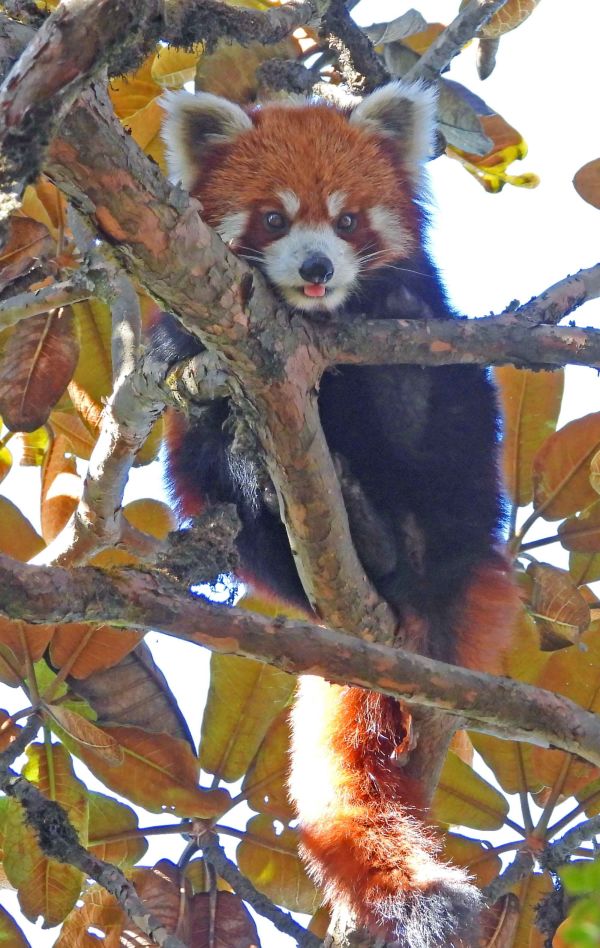Surya Ramachandran
THE LAND OF THE FIREFOX

With an estimated global population of less than 4000 individuals, a number which is highly questionable because of the lack of extensive studies across their habitat, the red panda or ‘Himalayan firefox’ is one of the most secretive, vulnerable and poorly understood animals of the Himalaya.
Its range extends through dense broadleaf, pine and bamboo forests, a biodiversity rich habitat that occupies mountain slopes between roughly 8,000 and 12,000 feet (2.400 and 3.600 meters). Singalila National Park on the Indo-Nepal border is one of the best places to see them in the wild.

The adventure begins…
The national park has to be accessed by a grueling two hour Land Rover drive on what could have once been called a road. We began our search from Kayakatta, a tiny hamlet that rests on a ridge at an altitude of 10,000 feet. After a hot cup of chai we set off into the forest, hoping to get a lay of the land and catch some of the famed eastern Himalayan birdlife. Immediately, we spotted countless birds, such as the Streak-throated Yuhina, the Rusty cheeked Scimitar Babbler or the Blue Whistling Trush.



Spotting the first Red Panda
It was the third day when the first Red Panda was spotted! Once we got the news, the next few minutes were a big blur of excitement: bamboo undergrowth, slushy forest slopes and few falls before we could get to the spot. The tracker pointed to a large oak tree, a good distance away, where the panda was sleeping. We could see a part of the body, lit perfectly by the Himalayan sun. The name ‘firefox’ was truly apt.
My ATX spotting scope brought out the detail in every hair strand of the panda. We couldn’t get any closer as the hillside was too steep, so we had to content ourselves with views from the scope and a few digiscoped images using my phone mounted on the scope adapter.


Another one!
On our walk back, we got another call about a large female in the area. Unlike our first panda, she was active and feeding among bamboo. We decided to head there immediately - and there she was… moving between branches, keeping a close eye on us. She stopped to grab a bamboo clump with her dark paws and started feeding. I clicked a few images and spent the rest of the time watching her with my binoculars, despite the fact that she was so close. I could observe the details of her ears, eyes, the raccoon-like face and the red pelt.

Some facts about
the red panda
Learning about panda habits, their feeding preferences and the seasonal changes in their habitat helps the local guides in their tracking. Pandas are active through the day and night, feeding every few hours, quenching their thirst and returning back to the canopy to sleep. Bamboo forms a large part of their diet throughout the year. Their mouth and digestion are designed specially to help digest this leaf and the cellulose content that it brings along. These unique characteristics classify pandas under a separate monotypic genus: Ailurus.
The next day dawned bright and clear, having already seen two red pandas, we were quite content to dive back into the avifauna. On one of these walks, to our total disbelief, we stumbled across a large male panda. It was the most satisfying experience because we managed to find one on our own. He sat just off the path, on a large tree, scratching himself and licking his paws. It was beautiful to watch him move through the canopy.

Back home after an exciting trip
On our last day, we bid farewell to our drivers on reaching the Indian town of Maneybhanjan and then carried on driving further into the Indian mainland with a multitude of interesting thoughts in our heads and a sense of achievement in our hearts.
It was an interesting trip where we met the first set of villages that were inviting keen enthusiasts to try and see the lesser known panda in their backyard forest. Locals who were earlier clearing out large tracks of forest land and even hunting pandas for the trade are now working as trackers or as members of the wildlife department. This is surely the first step of conservation, to realize the importance of the biodiversity in your own home

About
Surya Ramachandran
Surya Ramachandran is academically an engineer from the south indian city of Chennai who later pursued his passion into the wild. His jungle journey that commenced in the forests of Satpura at Forsyths, started as an intern and then later turned into a full time naturalist. He currently is working on creating wildlife tours in off the map destinations and setting up wildlife lodges and experiences in Ladakh in the trans-Himalayas with snow leopard and other lesser fauna present there as the focus.

